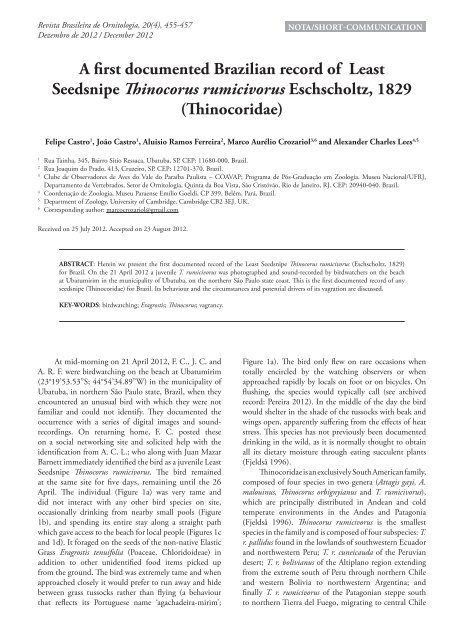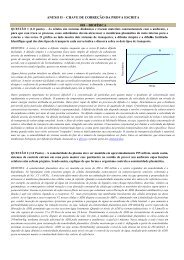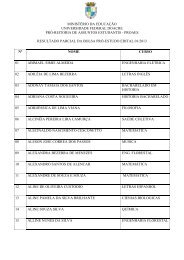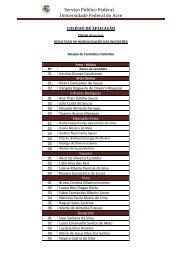Revista Brasileira de Ornitologia - Universidade Federal do Acre
Revista Brasileira de Ornitologia - Universidade Federal do Acre
Revista Brasileira de Ornitologia - Universidade Federal do Acre
Create successful ePaper yourself
Turn your PDF publications into a flip-book with our unique Google optimized e-Paper software.
<strong>Revista</strong> <strong>Brasileira</strong> <strong>de</strong> <strong>Ornitologia</strong>, 20(4), 455-457Dezembro <strong>de</strong> 2012 / December 2012NOTA/SHORT-COMMUNICATIONA first <strong>do</strong>cumented Brazilian record of LeastSeedsnipe Thinocorus rumicivorus Eschscholtz, 1829(Thinocoridae)Felipe Castro 1 , João Castro 1 , Aluisio Ramos Ferreira 2 , Marco Aurélio Crozariol 3,6 and Alexan<strong>de</strong>r Charles Lees 4,51Rua Tainha, 345, Bairro Sítio Ressaca, Ubatuba, SP. CEP: 11680-000. Brazil.2Rua Joaquim <strong>do</strong> Pra<strong>do</strong>, 413, Cruzeiro, SP. CEP: 12701-370. Brazil.3Clube <strong>de</strong> Observa<strong>do</strong>res <strong>de</strong> Aves <strong>do</strong> Vale <strong>do</strong> Paraíba Paulista – COAVAP; Programa <strong>de</strong> Pós-Graduação em Zoologia. Museu Nacional/UFRJ,Departamento <strong>de</strong> Vertebra<strong>do</strong>s, Setor <strong>de</strong> <strong>Ornitologia</strong>, Quinta da Boa Vista, São Cristóvão, Rio <strong>de</strong> Janeiro, RJ. CEP: 20940-040. Brazil.4Coor<strong>de</strong>nação <strong>de</strong> Zoologia, Museu Paraense Emílio Goeldi, CP 399, Belém, Pará, Brazil.5Department of Zoology, University of Cambridge, Cambridge CB2 3EJ, UK.6Corresponding author: marcocrozariol@gmail.comReceived on 25 July 2012. Accepted on 23 August 2012.ABSTRACT: Herein we present the first <strong>do</strong>cumented record of the Least Seedsnipe Thinocorus rumicivorus (Eschscholtz, 1829)for Brazil. On the 21 April 2012 a juvenile T. rumicivorus was photographed and sound-recor<strong>de</strong>d by birdwatchers on the beachat Ubatumirim in the municipality of Ubatuba, on the northern São Paulo state coast. This is the first <strong>do</strong>cumented record of anyseedsnipe (Thinocoridae) for Brazil. Its behaviour and the circumstances and potential drivers of its vagration are discussed.KEY-WORDS: birdwatching; Eragrostis; Thinocorus; vagrancy.At mid-morning on 21 April 2012, F. C., J. C. andA. R. F. were birdwatching on the beach at Ubatumirim(23°19’53.53”S; 44°54’34.89”W) in the municipality ofUbatuba, in northern São Paulo state, Brazil, when theyencountered an unusual bird with which they were notfamiliar and could not i<strong>de</strong>ntify. They <strong>do</strong>cumented theoccurrence with a series of digital images and soundrecordings.On returning home, F. C. posted theseon a social networking site and solicited help with thei<strong>de</strong>ntification from A. C. L.; who along with Juan MazarBarnett immediately i<strong>de</strong>ntified the bird as a juvenile LeastSeedsnipe Thinocorus rumicivorus. The bird remainedat the same site for five days, remaining until the 26April. The individual (Figure 1a) was very tame anddid not interact with any other bird species on site,occasionally drinking from nearby small pools (Figure1b), and spending its entire stay along a straight pathwhich gave access to the beach for local people (Figures 1cand 1d). It foraged on the seeds of the non-native ElasticGrass Eragrostis tenuifolia (Poaceae, Chlori<strong>do</strong>i<strong>de</strong>ae) inaddition to other uni<strong>de</strong>ntified food items picked upfrom the ground. The bird was extremely tame and whenapproached closely it would prefer to run away and hi<strong>de</strong>between grass tussocks rather than flying (a behaviourthat reflects its Portuguese name ‘agacha<strong>de</strong>ira-mirim’;Figure 1a). The bird only flew on rare occasions whentotally encircled by the watching observers or whenapproached rapidly by locals on foot or on bicycles. Onflushing, the species would typically call (see archivedrecord: Pereira 2012). In the middle of the day the birdwould shelter in the sha<strong>de</strong> of the tussocks with beak andwings open, apparently suffering from the effects of heatstress. This species has not previously been <strong>do</strong>cumenteddrinking in the wild, as it is normally thought to obtainall its dietary moisture through eating succulent plants(Fjeldså 1996).Thinocoridae is an exclusively South American family,composed of four species in two genera (Attagis gayi, A.malouinus, Thinocorus orbignyianus and T. rumicivorus),which are principally distributed in An<strong>de</strong>an and coldtemperate environments in the An<strong>de</strong>s and Patagonia(Fjeldså 1996). Thinocorus rumicivorus is the smallestspecies in the family and is composed of four subspecies: T.r. pallidus found in the lowlands of southwestern Ecua<strong>do</strong>rand northwestern Peru; T. r. cuneicauda of the Peruvian<strong>de</strong>sert; T. r. bolivianus of the Altiplano region extendingfrom the extreme south of Peru through northern Chileand western Bolivia to northwestern Argentina; andfinally T. r. rumicivorus of the Patagonian steppe southto northern Tierra <strong>de</strong>l Fuego, migrating to central Chile










